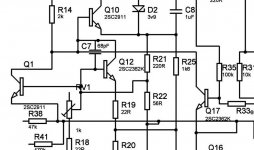russel_h said:Hi,
Not quite sure what you mean, I used the balance equation in Hawksfords paper to get a set of resistor values that were close to preferred values. Once you have done that then you should not need to change them.
regards
Sorry for my poor English
 .
.OK.You just answer my question😉 .Thanks again.
good luck
X.G.
X.G.
There is a practical way to adjust error correction. It is posted by Steven in "Etalon" thread.
Russel,
Whats the voltage of this design? I think that error correction makes the amp not so efficient in using Vrails, because the error correction itself needs some voltages to consume. The voltage losses is big.
There is a practical way to adjust error correction. It is posted by Steven in "Etalon" thread.
Russel,
Whats the voltage of this design? I think that error correction makes the amp not so efficient in using Vrails, because the error correction itself needs some voltages to consume. The voltage losses is big.
lumanauw said:X.G.
There is a practical way to adjust error correction. It is posted by Steven in "Etalon" thread.
I read the thread a few months ago...but I did not attention the detail

Thanks,lumanauw
http://www.diyaudio.com/forums/showthread.php?s=&threadid=32913&highlight=
>Whats the voltage of this design? I think that error correction makes >the amp not so efficient in using Vrails, because the error correction >itself needs some voltages to consume. The voltage losses is big.
OK if you are on a limited budget for mass market products its not a technique to use, but its not that large compared the Vgs needed to get a FET to pass a large current. You could run the error correcting circuit off higher voltage rails if you think its a problem. I think its worth sacrificing a few watts for the increase in sound quality EC brings. The supply voltage I use is about +/- 50 volts.
OK if you are on a limited budget for mass market products its not a technique to use, but its not that large compared the Vgs needed to get a FET to pass a large current. You could run the error correcting circuit off higher voltage rails if you think its a problem. I think its worth sacrificing a few watts for the increase in sound quality EC brings. The supply voltage I use is about +/- 50 volts.
Hi, Russel,
For ordinary power amp, we can easily arrange 2PS to overcome drops like Upupa Epops said. But there is a serious problem if we try to use 2 PS for error correction type amp. Assume we use +/-70V for front side while the output stages are +/-50V. Both PS have to turn on and off at exactly the same time. If not, while the output is tied to speaker, the drivers around the VBE multiplier/VAS will be burned, because the final stage acting as Diode connected to the speaker.
Since EC have better efficiency with 2 PS, I still dont know how to arrange these 2 PS safely. Do you have an idea how to use EC with 2 PS?
For ordinary power amp, we can easily arrange 2PS to overcome drops like Upupa Epops said. But there is a serious problem if we try to use 2 PS for error correction type amp. Assume we use +/-70V for front side while the output stages are +/-50V. Both PS have to turn on and off at exactly the same time. If not, while the output is tied to speaker, the drivers around the VBE multiplier/VAS will be burned, because the final stage acting as Diode connected to the speaker.
Since EC have better efficiency with 2 PS, I still dont know how to arrange these 2 PS safely. Do you have an idea how to use EC with 2 PS?
Since EC have better efficiency with 2 PS, I still dont know how to arrange these 2 PS safely. Do you have an idea how to use EC with 2 PS?
Try using an arrangement as in the diagram, if you add T1 as shown both FET and driver aill have there own current limits. Obviously the lower half needs a PNP transistor in its appropriate postion. If you need more current make up the 56 ohms with two resistors, the bottom one setting the current limit.
Try using an arrangement as in the diagram, if you add T1 as shown both FET and driver aill have there own current limits. Obviously the lower half needs a PNP transistor in its appropriate postion. If you need more current make up the 56 ohms with two resistors, the bottom one setting the current limit.
Attachments
- Status
- Not open for further replies.
- Home
- Amplifiers
- Solid State
- FET amplifier

